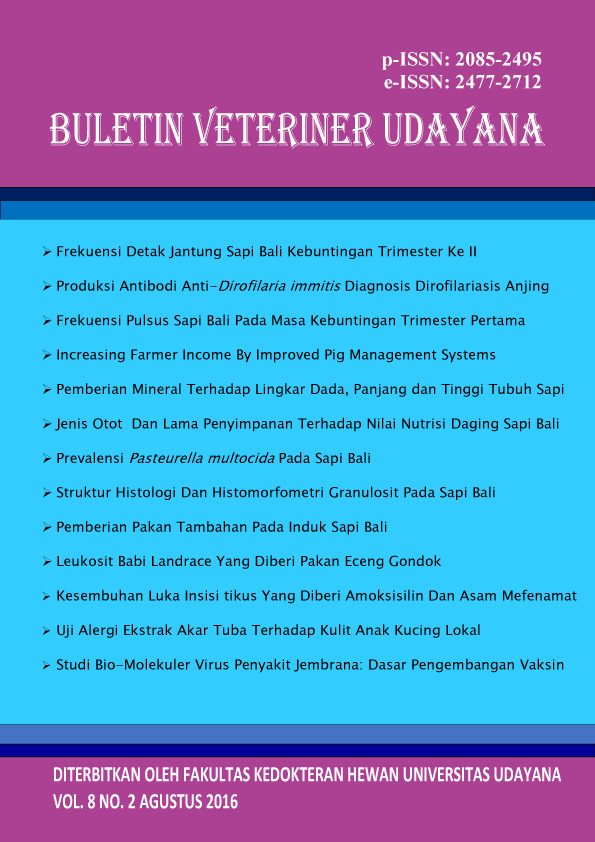THE PRODUCTION OF ANTI-Dirofilaria immitis ANTIBODIES FOR THE DIAGNOSIS DEVELOPMENT OF DIROFILARIASIS IN DOGS
Abstract
Dirofilaria immitis (D. immitis) as a causative agent of heartworm disease is not only caused problems in animals but also zoonoses. For diagnosis of dirofilariasis (disease caused by D. immitis) serologically is needed anti-D. immitis antibodies. The objective of this study was to produce antibodies against excretory-secretory antigens produced by male and female worms for developing the diagnosis of dirofilariasis based on the antigens detection. Base on this study can be concluded that male excretory-secretory antigens (MES), female excretory-secretory antigens (FES), and MES+FES can stimulate BALB/c mouse to produce polyclonal antibodies in the same pattern. Antibodies have been produced at day 21 and the peak titter was at day 35 after first immunization.
Downloads
References
Alia YY, May HK, Amall HA. 2013. Serological study of Dirofilaria immitis in human from some villages in Al-Hindya part of Karbala Governorate. Int J of Sci and Nature, 4: 185–188.
Aranda C, Panyella O, Eritja R, Castella J. 1998. Canine filariasis importance and transmission in the Baix Llobregat area, Barcelona (Spain). Vet Parasitol, 77: 267–275.
Bolio-Gonzalez ME, Rodriguez-Vivas RI, Sauri-Arceo CH, Gutierrez-Blanco E, Ortega-Pacheco A, Colin-Flores RF. 2007. Prevalence of the Dirofilaria immitis infection in dogs from Merida, Yucatan, Mexico. Vet Parasitol, 148: 166–169.
Cruz-Chan JV, Quijano-Hernandez I, Ramirez-Sierra MJ, Dumonteil E. 2009. Dirofilaria immitis and Trypanosoma cruzi natural co-infection in dogs. The Vet J doi: 10.1016/j.tvjl.2009. 09.012.
Genchi C, Rinaldi L, Mortarino M, Genchi M, Cringoli G. 2009. Climate and Dirofilaria infection in Europe. Vet Parasitol, 163: 286–292.
Goodwin J-K. 1998. The serologis diagnosis of heartworm infection in dogs and cats. Clinical Techniques in Small Animals Practice, 13: 83–87.
Grieve RB, Mika-Johnson M, Jacobson RH, Cypress RH. 1981. Enzyme-linked immunosorbent assay for measurement of antibody responses to Dirofilaria immitis in experimentally infected dogs. Am J Vet Res, 42: 66–69.
Hayasaki M, Nakagaki K, Kobayashi S, Ahishi I. 1981. Immunological response of dogs to Dirofilaria immitis infection. Jpn J Vet Sci, 43: 909–914.
Maizels RM, Blaxter ML, Robertson BD, Selkirk ME. 1991. Parasite Antigens, Parasite Genes. A Laboratory Manual for Molecular Parasitology. Cambridge University Press, New York, Port Chester, Melbourne, Sydney.
Marcos-Atzutegi C, Kramer LH, Fernandez I, Simoncini L, Genchi M, Prieto G, Simon F. 2003. TH1 response in BALB/c mice immunized with Dirofilaria immitis soluble antigens: a possible role for Wolbachia? Vet Parasitol, 112: 117–130.
Meriem-Hind BM, Mohamed M. 2009. Prevalence of canine Dirofilaria immitis infection in the city of Algiers, Algeria. African J of Agri Res, 4: 1097–1100.
Reifur L, Thomaz-Socco V, Montiani-Ferreira F. 2004. Epidemiological aspects of filariosis in dogs on the coast of Parana state, Brazil: with emphasis on Dirofilaria immitis. Vet Parasitol, 122: 273–286.
Song KH, Hayasaki M, Cholic C, Cho KW, Han HR, Jeong BH, Jeon MH, Park BK, Kom DH. 2002. Immunological responses of dogs experimentally infected with Dirofilaria immitis. J Vet Sci, 3: 109–114.
Suyoko. 1998. Pengembangan antibodi monoklonal spesifik terhadap antigen beredar Brugia malayi untuk diagnosis filariasis malayi. Disertasi. Universitas Gadjah Mada.
Weil GJ, Ottesen EA. 1981. Dirofilaria immitis: parasiti-specific humoral and cellular immune responses in experimentally infected dogs. Exp Parasitol, 51: 80–86.
Weil GJ. 1987. Dirofilaria immitis: Identification and Partial Characterization of Parasite Antigens in the Serum of Infected Dogs. Exp Parasitol, 64: 244–251.





